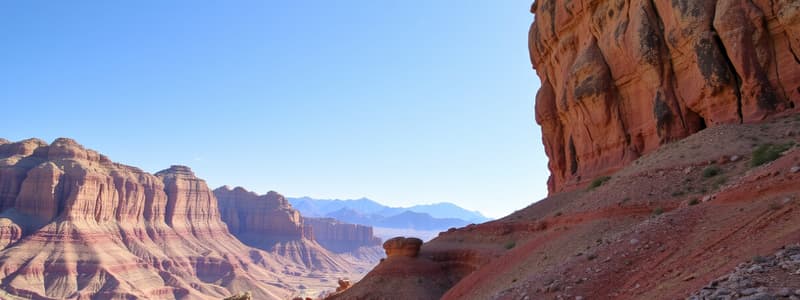Podcast
Questions and Answers
Which of the following best defines geomorphology?
Which of the following best defines geomorphology?
- The study of human cultures and populations
- The analysis of fossil records
- The study of landforms and their processes (correct)
- The science of climate and weather patterns
Physical geography includes the study of cultural patterns.
Physical geography includes the study of cultural patterns.
False (B)
What are two examples of erosional landforms?
What are two examples of erosional landforms?
Canyons and cliffs
Geomorphology studies the _____ and processes that create the land surface.
Geomorphology studies the _____ and processes that create the land surface.
Match the following terms with their descriptions:
Match the following terms with their descriptions:
Which of the following is NOT a component of physical geography?
Which of the following is NOT a component of physical geography?
Mountains and rivers are considered examples of landforms.
Mountains and rivers are considered examples of landforms.
Describe the relationship between physical processes and landform creation.
Describe the relationship between physical processes and landform creation.
Study Notes
Physical Geography and Geomorphology
- Physical geography explores the natural environment, involving processes and patterns affecting Earth's features.
- Human geography examines cultural aspects, population distributions, and demographics, emphasizing social sciences.
Definition of Geomorphology
- Geomorphology is the study of landforms, focusing on their nature, origins, development processes, and material composition.
- It is defined as the science concerned with the morphology of the land surface and the processes that shape it.
Understanding Landforms
- Landforms are defined by the morphology and character of the land surface arising from physical processes (like fluvial and wind actions) and geological movements (such as faulting and folding).
- Examples include mountains, rivers, and dunes, showcasing the diverse structures formed through natural processes.
Erosional and Depositional Landforms
- Erosional landforms:
- Created through the process of erosion, which involves the removal and transport of sediment.
- Erosional processes leave distinct landforms behind due to the wearing away of materials.
- Depositional landforms:
- Formed by the deposition of sediment, resulting in the accumulation and layering of materials.
- These landforms arise as sediment is laid down, creating new geological features.
Studying That Suits You
Use AI to generate personalized quizzes and flashcards to suit your learning preferences.
Related Documents
Description
This quiz introduces the fundamentals of geomorphology, focusing on Southern Africa's physical geography. It covers the processes and patterns in the natural environment as well as key concepts in earth science. Engage with this essential foundation for understanding geomorphological features.




